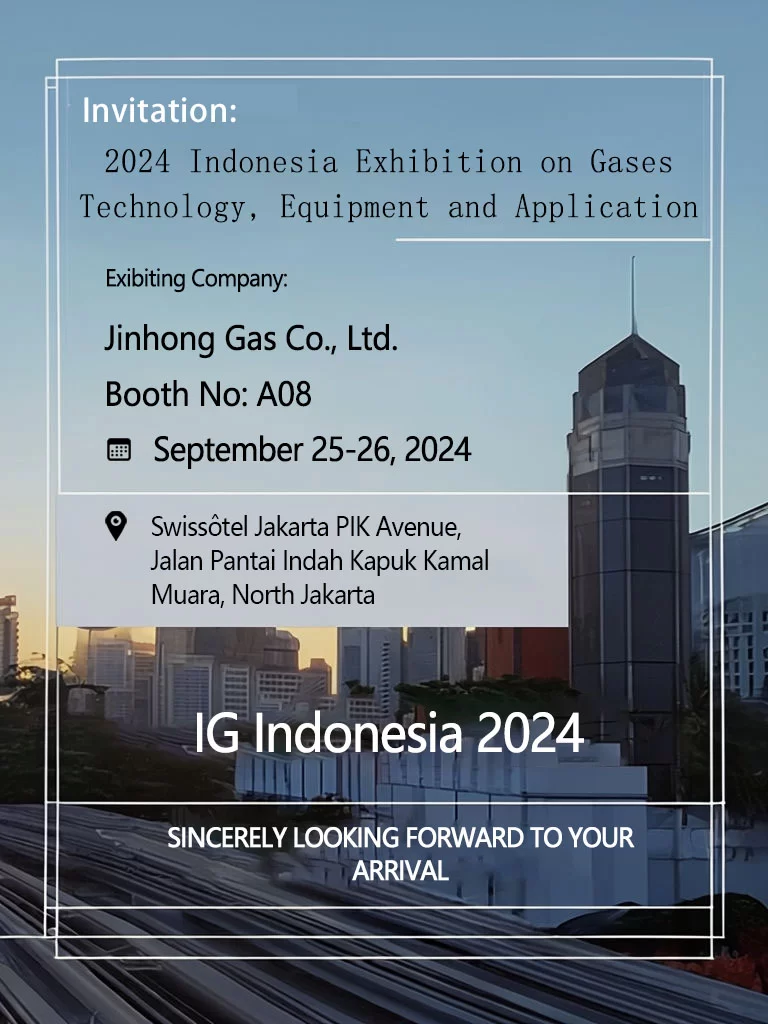
Date:Oct 08 2023


Join Us at Booth A08 in North Jakarta on September 25-26, 2024 We are thrilled to announce that JinhongGas will be participating in the‘2024 Indonesia Exhibition on Gases Technology, Equipment, and Application’. This prestigious event, held atJalan Pantai Indah Kapuk Kamal Muara, North Jakarta, is a key platform for showcasing the latest innovations in gas technology and equipment. We invite all our valued clients and partners to visit us atBooth A08. At this exhibition, JinhongGas will highlight our most advanced products and services, designed to meet the evolving needs of industries across the globe. Whether you are interested in efficient gas supply solutions, cutting-edge equipment, or sustainable applications, our team of experts

Visit Us at the International Center for Exhibition (I.C.E), Hanoi, from September 11-13, 2024 We are excited to announce that JinhongGas will be participating inNEPCON Vietnam 2024, a leading event for electronics manufacturing and technology. The exhibition will be held at theInternational Center for Exhibition (I.C.E), 91 Tran Hung Dao Street, Hanoi, Vietnam, fromSeptember 11-13, 2024,from 9:00 AM to 5:00 PMdaily. As a trusted provider of industrial gases and cutting-edge technology solutions, JinhongGas is eager to showcase our latest products and innovations at this prestigious event. Our offerings are designed to enhance efficiency, sustainability, and reliability in the electronics manufacturing industry, providing our customers with the tools they need to stay ahead

Air separation technology is one of the pivotal industrial technologies of the modern era, extensively used in the production of gases such as oxygen, nitrogen, and argon. It plays a critical role in sectors including metallurgy, chemicals, and healthcare. From its early, rudimentary separation devices to today’s high-efficiency and precision systems, air separation technology has undergone significant evolution. This article explores the development of air separation technology and its future trends. Ⅰ.The Evolution of Air Separation Technology The origins of air separation technology can be traced back to the late 19th and early 20th centuries. Initially, air separation relied on physical methods such as cooling and compression to separate the primary gas components.

Air separation technology is one of the pivotal industrial technologies of the modern era, extensively used in the production of gases such as oxygen, nitrogen, and argon. It plays a critical role in sectors including metallurgy, chemicals, and healthcare. From its early, rudimentary separation devices to today’s high-efficiency and precision systems, air separation technology has undergone significant evolution. This article explores the development of air separation technology and its future trends. Ⅰ.The Evolution of Air Separation Technology The origins of air separation technology can be traced back to the late 19th and early 20th centuries. Initially, air separation relied on physical methods such as cooling and compression to separate the primary gas components.

On December 13, Prof. Truls Eivind Norby, academician of Norwegian Academy of Sciences, and experts from Soochow University and Soochow University of Science and Technology visited JinHong Gas to investigate our hydrogen products and related technologies and conduct in-depth discussion with Dr. Sun, director of Jinhong Gas R&D Center. Prof. Truls Eivind Norby is one of the world’s four leading authorities on solid ionic conductors, especially solid proton conductors. He received his Ph.D. degree from the University of Oslo in 1986 and was a Research Fellow of the Nordic Energy Research Program and a postdoctoral fellow at the University of Oslo from 1987 to 1993. He is currently a professor of chemistry and head
This website uses cookies to improve your browsing experience. By continuing to use this website, you agree to our use of cookies.